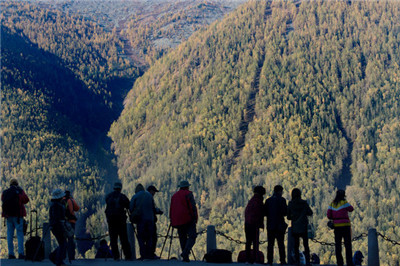【新疆旅游】新疆游客人数因安全形势恶化锐减
KANAS LAKE, China — The two amateurphotographers stood on a hill overlooking thesparkling river in this remote alpine park, waitingfor nomads to emerge from their white yurts andherd cows across a bridge.
中国喀纳斯湖——在这个偏远的高山公园,两名摄影爱好者站在一座小山上,俯瞰着波光粼粼的河流,等着游牧民走出他们白色的圆顶帐篷,赶着牛群过桥。
The men, both age 60, were driving on a one-monthroad trip through the western region of Xinjiang tocapture scenes like this one.
同为60岁的这两名男子,正在西部新疆地区进行为期一个月的自驾游,以捕捉这样的场景。

“Don’t listen to what other people say about Xinjiang and don’t believe what you read,” saidSun Jingchuan, a retired aircraft maintenance worker from Sichuan Province in southwestChina. “It’s very safe here.”
“别听其他人说的关于新疆的事情,别相信你在报纸上看到的东西,”来自四川的退休飞机维修人员孙京川(音译)说。“这儿非常安全。”
Many other Chinese would dispute that assessment. This year, after a stream of newsreports of rioting, terrorist attacks and deadly police shootings linked to ethnic conflict intowns across Xinjiang, tourism has plummeted, the first drop in 20 years.
许多中国人可能会怀疑这样的评价。今年,在一连串新闻报道介绍新疆各地城镇发生的和民族冲突有关的暴乱、恐怖袭击和警方击毙暴徒事件后,新疆的旅游业大幅下滑,这是20年来的首次下滑。
Xinjiang, the size of Western Europe, has long been considered one of China’s most exoticdestinations. Chinese tourists, usually traveling in tour groups, visit the grasslands and Siberianforests here in the north and desert oasis towns in the south, along the old Silk Road.
长期以来,面积和西欧一般大的新疆,一直被认为是中国最具异域风情的旅游目的地之一。国内游客通常会跟着旅行团,沿着古代的丝绸之路,游览北疆的草原和西伯利亚森林,以及南疆的沙漠绿洲城镇。
Among the locals, an estimated 1.5 million people have some tie to Xinjiang’s tourismeconomy, and many were hoping for a big surge in visitor numbers during the National Dayholiday week in China, which began Wednesday. But given reports in late September of dozenskilled in clashes, there is little expectation that the numbers will match those of previousyears.
在新疆的当地人中,估计有150万人与新疆的旅游经济有着某种关联,而且许多人本希望在从周三开始的国庆节长假期间,游客人数能大增。但考虑到9月末有关几十人在冲突中死亡的报道,现在几乎没人指望今年的游客人数能达到往年的水平。
On the morning Mr. Sun and his friend were photographing cows and Kazakh nomads, a reporton an official Xinjiang news website said multiple explosions days earlier in Luntai County hadkilled two people and wounded many others. The website later reported that 40 rioters had died— some were shot by the police, others blew themselves up — while six civilians and four policeofficers and auxiliary employees were killed. Radio Free Asia, financed by the United Statesgovernment, said the attackers were furious over land seizures by officials. It was the deadliestburst of violence in Xinjiang in weeks, but was not atypical.
就在孙京川和朋友拍摄牛群和哈萨克游牧民的那个上午,新疆一家官方新闻网站上的一篇报道称,几天前轮台县发生的多起爆炸导致两人死亡,其他许多人受伤。该网站后来报道称,有40名暴徒死亡——部分是被警方击毙的,其他人是自己引爆了炸弹——还有六名平民、四名警察和协警。接受美国政府资助的自由亚洲电台(Radio Free Asia)表示,袭击者对官员的征地行为感到愤怒。这是数周来新疆发生的人员伤亡最惨重的暴力事件,但却并非罕见。
In the first half of this year, visits from domestic tourists dropped 7 percent, to 20 million,compared to the same period last year, according to official statistics. The revenue fromdomestic tourists fell nearly 6 percent, to $3.5 billion.
官方统计数据显示,今年上半年,来新疆的国内游客人次跌至2000万,与去年同期相比减少7%。国内游客带来的收入跌至35亿美元(约合214亿元人民币),降幅接近6%。
Foreign tourism, which is a fraction of the total, also dropped, by nearly 1 percent, to 619,300,with revenue falling 1 percent, to $161 million. The Xinjiang Regional Tourism Bureau blames“influences from recent terrorist attacks” for the downturn.
在新疆总体旅游业中仅占一小部分的涉外旅游也出现了下滑,降至61.93万人次,降幅接近1%,收入也减少了1%,跌至1610万美元。新疆维吾尔自治区旅游局将其归咎于“受暴恐案件影响”。
In early August, some Chinese-language news websites published an open letter deploring the“great harm” done to the Xinjiang tourism industry by “violent terrorism attacks.” The lettersaid it represented the 400,000 people directly employed in Xinjiang tourism. Shen Qiao, thedeputy chief editor of the Xinjiang bureau of the official Xinhua news agency, said that “peoplefrom the mainland feel scared when talking about Xinjiang.”
8月初,部分中文新闻网站刊登了一封公开信,谴责“暴恐案件”给新疆旅游业带来了“巨大的伤害”。该信称自己代表新疆旅游业的40万从业者。官方通讯社新华社新疆分社副总编沈桥称,“说到新疆时,来自内地的人会感到害怕。”
On online travel forums, the question “Is it safe to travel in Xinjiang?” is common. On oneforum, people wrote that it was better to go to northern Xinjiang, where there are fewerUighurs, a minority ethnic group whose clashes with the Han majority account for much ofthe violence, and more Kazakhs, Mongolians and other ethnic minorities. Violence in Urumqi,the regional capital, and in the south has been greater.
在网上旅游论坛中,“去新疆旅游安全吗”这个问题很常见。在其中一个论坛上,人们写道,最好去北疆,那里的维吾尔族更少,哈萨克族、蒙古族和其他少数民族更多。维吾尔族是一个少数民族,其与人口占多数的汉族的冲突,造成了许多暴力事件。
So desperate are Xinjiang officials to draw tourists that they issued $3.2 million worth of“travel cards” from January to April to tourists visiting with tour groups. The cards, worth $80each, could be used to pay for hotels, attractions and local products.
新疆官员极度希望能吸引游客,从1月到4月,他们甚至向随团来的游客发放了价值2000万元的“旅游卡”。这些旅游卡每张面值500元,可以用来支付酒店、旅游景点和当地产品的费用。
[NextPage]
Many Han have long held negative stereotypes of Uighurs, as petty thieves, for example, butattitudes hardened after rioting in 2009 in Urumqi resulted in at least 200 deaths, most of themHan. Uighurs say much of their anger grows from long-running discrimination by the Han. Thegovernment blames Uighur separatists for most of the attacks.
长期以来,许多汉族人都对维吾尔族人持有偏见,例如,有人总把他们视为小偷。但是,在2009年乌鲁木齐发生暴乱之后,这种观点得到了强化。当时,暴乱共导致至少200人死亡,其中大多是汉族人。维吾尔族人称,他们之所以感到愤怒,主要是因为汉族人长期的歧视。政府则始终认为,维吾尔族的分裂分子应该对大部分袭击负责。
Even in northern Xinjiang, far from the Uighur heartland, tourism workers say business issuffering. “This year has been slow,” said Chen Yan, 37, a masseuse from Sichuan who worksevery summer at a hotel in Burqin, a mostly Kazakh town that is the gateway to Kanas Lake.
即便在远离维吾尔族中心地带的新疆北部,旅游工作者都表示他们的业务比较惨淡。“今年人很少,”37岁的陈燕(音译)说。她是四川的一位按摩师,每年夏天都会到布尔津的一家酒店工作。这个县在通往喀纳斯湖的入口,居民主要是哈萨克人。
Ms. Chen said she had made about $650 a month this season, compared with about $1,000 amonth last summer, earnings that help support a 14-year-old son and a husband who does oddjobs, both in Sichuan.
陈燕说,这一季,她每个月能挣大约650美元,去年夏天则大约能挣1000美元,这些钱能帮她养活一个14岁的儿子和打零工的丈夫,他们都在四川。
A Kazakh driver in the town, Sailin, said, “Each year, business gets worse.”
县里的哈萨克族司机赛林(Sailin,音译)说,“生意是一年不如一年。”
As Kanas Lake has become more popular with tourists in recent years — in part because of thelegend of a Lochness-style monster that lurks in the waters — hotel construction has boomedin the park and on its periphery. But managers say occupancy rates are low this year.
近年来,随着喀纳斯湖越来越受游客欢迎——部分是因为湖水里有个类似尼斯湖水怪的怪物传说——人们开始在公园及其附近兴建酒店。但管理人员说,今年的入住率较低。
At the lake, dozens of visitors boarded white speedboats one afternoon for a tour. But in pastyears, there were many more people, said Sultanate, a Kazakh man who worked at the parkentrance. “The captain of one of the boats spends all day wiping the windows,” he said.
某天下午在喀纳斯湖,数十名游客登上白色快艇观光。但是在公园入口工作的哈萨克族人苏尔塔纳提(Sultanate,音译)说,往年游客要多很多,“有条船的船长整天都在擦窗户。”
Employees at Koktokay, or Kekutuohai in Chinese, a park in the far north, said they had noticeda decline in visitors from outside Xinjiang.
可可托海国家地质公园(Koktokay)位于新疆北部偏远地区。这里的工作人员说,他们注意到来自新疆以外地区的游客人数减少了。
But overall numbers are up this year compared to last, reflecting an increase in visitors fromXinjiang, possibly because more are choosing to visit the north since it has fewer Uighurs.
但是与去年相比,游客人数总体还是增加了,这反映了来自新疆的游客出现增加,或许是因为越来越多的人都选择前往北部旅游——因为那里的维吾尔族人较少。
There were exceptions, of course. One afternoon, a group of seven men who worked forBaosteel Group in different parts of the country rode together on a golf cart through the park’scentral valley, carved by the Irtysh River as it flows to the Arctic Ocean.
当然也有例外。一天下午,在中国不同地区为宝钢集团工作的七名男子乘坐同一辆高尔夫球车穿过了公园的中央谷地。额尔齐斯河经过这里,最后流入北冰洋。
On a bus ride, a 30-year-old woman from Zhejiang Province who was traveling with friends forthree months across Xinjiang, Tibet and Nepal said the park was beautiful, but other parts ofXinjiang held less appeal. “I’m afraid Kashgar is too dangerous,” she said, referring to thefabled Uighur caravan town in the south that has been a site of attacks.
一名来自浙江省的30岁女子是乘大巴前来的,她说这个公园很美,但新疆其他地方并没有太大的吸引力。她与朋友一道,花三个月时间穿越了新疆、西藏和尼泊尔。“我担心喀什会太危险,”她说。她指的是新疆南部有名的维吾尔族聚居城镇,那里曾出现过袭击事件。
Mr. Sun, the photographer in the Kanas Lake area, said only a handful of Uighurs were toblame. “In southern Xinjiang, a few violent individuals were able to coerce others into takingpart in violence,” he said. “One person would come to your home and say, ‘You’re a Uighur —do this or I’ll put a knife to the throat of your mother or sister.’ ”
喀纳斯湖地区的摄影师孙京川说,这只能怪少数维吾尔族人。“在南疆,一些暴力分子能够强迫他人参与暴力活动,”他说。“有人会来到你门前说,‘你是维族人——要么这样做,要么我把刀架你母亲或姐妹的喉咙上。’”
He had waited for the morning to get the shot of cows crossing the bridge, but they had notbudged from their pasture. He packed up his photo equipment and walked with his friend totheir car to drive to an ethnic Tuvan village. “Next year, we’ll go to southern Xinjiang,” he said. “I’ve never been there.”
他整个上午都在等待,希望能拍到牛群通过桥梁的照片,但它们并没有离开牧场。他收拾好自己的摄影器材,与朋友一起走到车旁,开车前往一个图瓦村庄。“明年,我们要去南疆,”他说。“我还从来没去过那里。”
本文来源:https://www.oubohk.cn/yingyu/295585/
新疆旅游最佳季节 新疆旅游攻略




